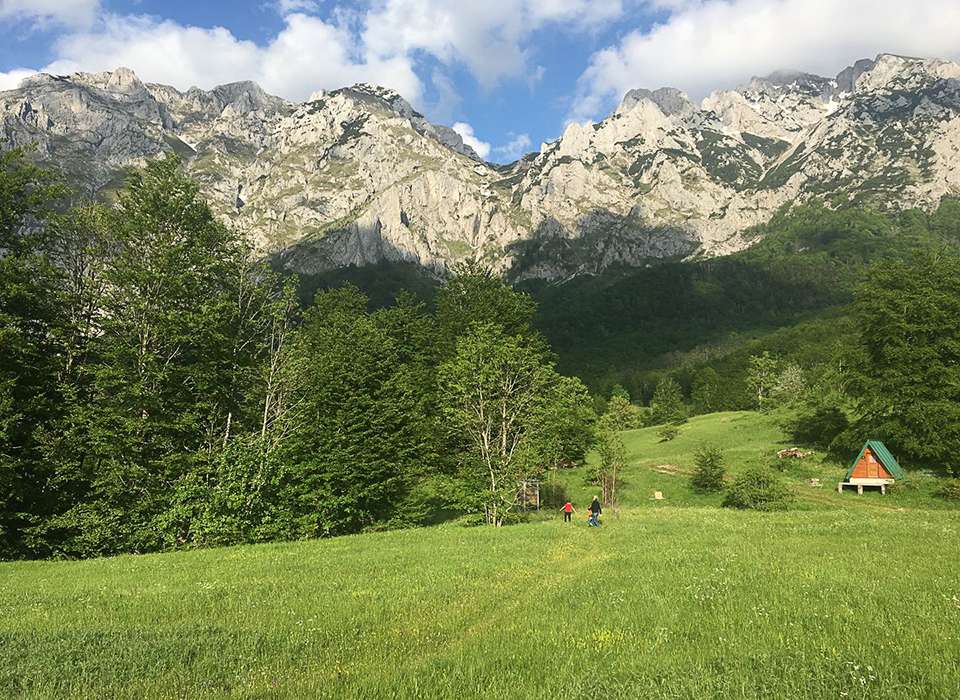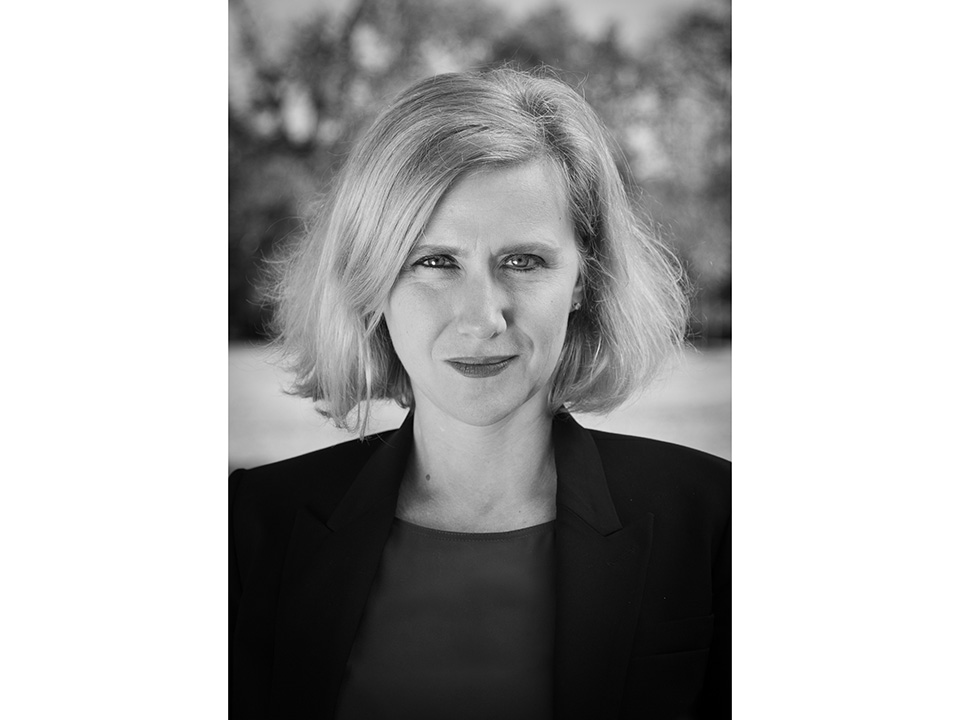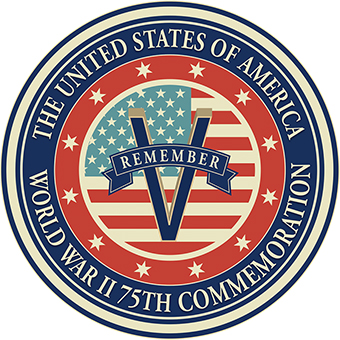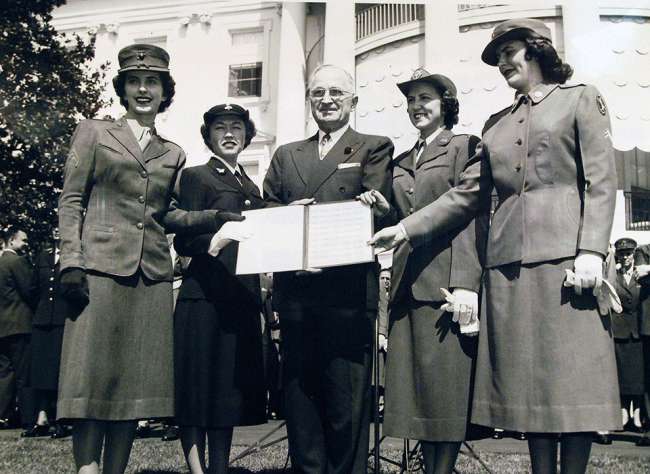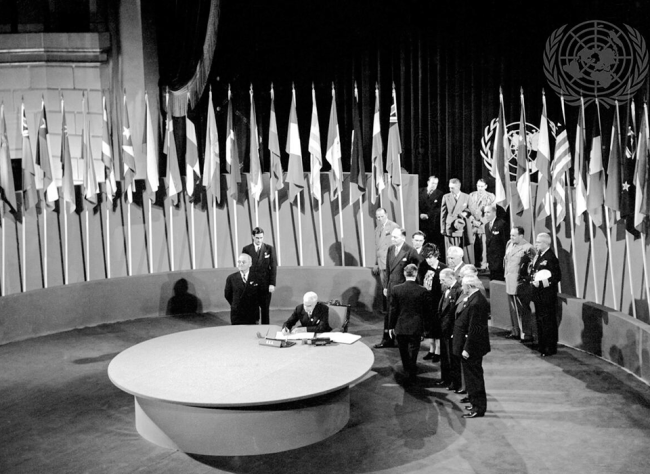Top Image: The author and her children exploring remote battle zones in the mountains separating Bosnia-Herzegovina and Montenegro, 2019.
In the fall of 1946, four Catholic Slovenes in Dezno, Slovenia stormed the home of a local Communist official, also a Slovene, and demanded that he turn over documents and food in his home. When the official refused, the men “beat him with the butts of their rifles” and stole what they wanted. As they departed, they set fire to his home and left a receipt that stated the Anti-Communist Army of Slovenia had requisitioned his goods and destroyed his documents.
The note ended with the phrase: “Freedom to the people, death to the Communists!” The slogan was an explicit reworking of the Communists’ own wartime slogan, “Death to fascism, freedom to the people!” By deploying the same rhetoric, the ideological enemies were claiming they legitimately represented the will of the people.
Across Yugoslavia, similar events occurred throughout 1946. In northeastern Bosnia, a group of armed Muslim men stormed the home of the local Communist chief, also a Muslim, ransacking his house and shooting at his son, who jumped through a window and ran for his life. In Kosovo, an Albanian killed the head of the Communist party, also an Albanian, in the doorway of his home: the assassin was part of an organized guerilla army that did not think Kosovo should be governed by Yugoslavia. In Serbia, armed insurgents, known as Chetniks, holed up in the mountains, often drawing on the support of priests and peasant networks to survive. In Croatia, wartime fascists refashioned themselves as “Crusaders” defending Christianity and the nation against Communism.
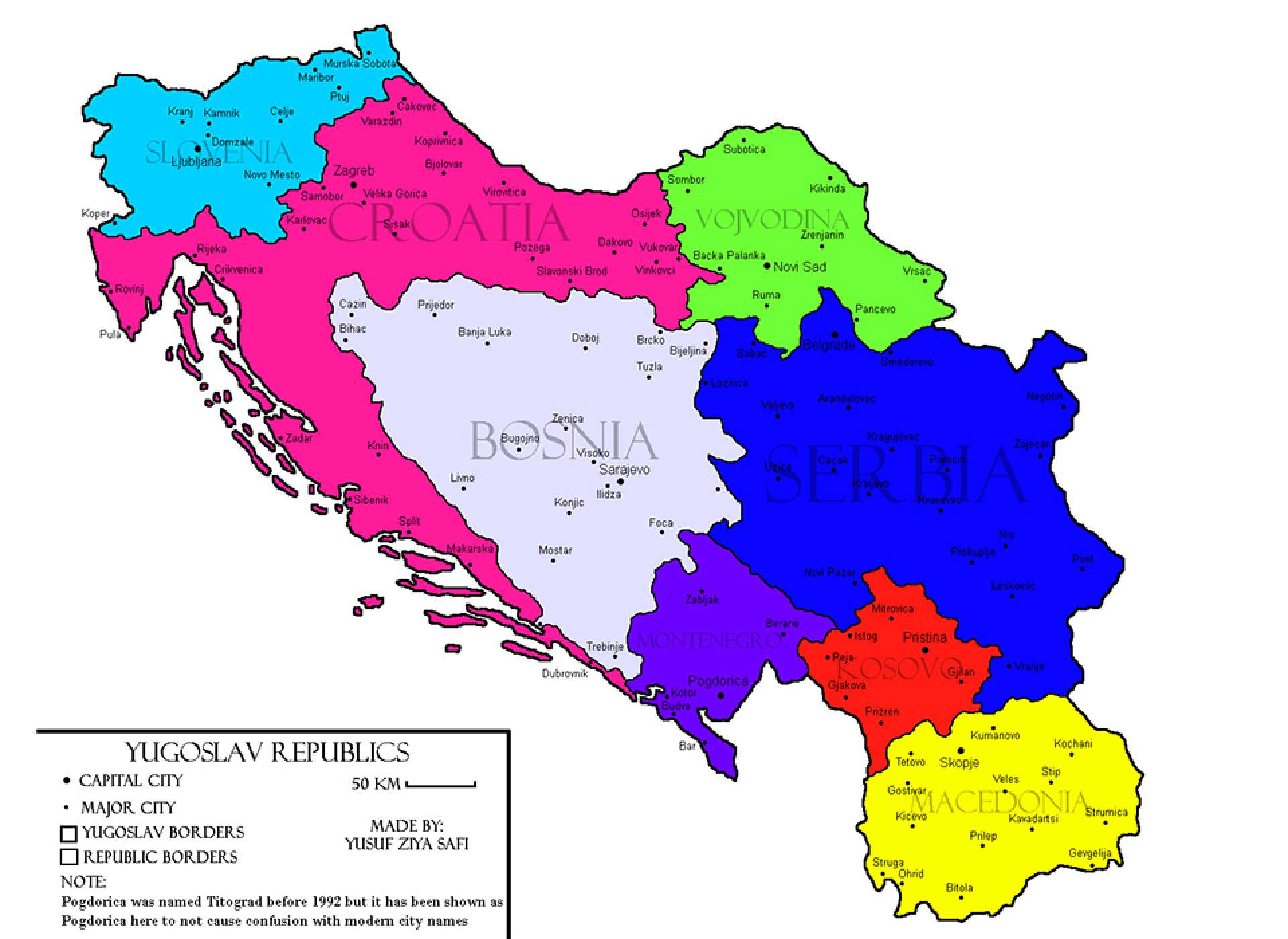
Socialist Yugoslavia courtesy of Wikimedia Commons.
Across the Balkans in 1945 and 1946, and indeed, much of Eastern Europe, armed conflict and civil resistance was widespread. World War II officially ended in Europe in the spring of 1945, when the German army retreated under pressure from Allied forces and local partisans. Occupation governments and quisling regimes collapsed, their many supporters either fleeing into hiding or facing prosecution. But the war’s supposed end was hardly a settled matter.
While the world would mark Victory Day (V-E Day) in Europe after Germany’s unconditional surrender on May 7, 1945 in many parts of Europe, local conflict persisted long after the last Wehrmacht tanks rolled away and foreign statesmen proclaimed peace. In the post-war transition, multi-sided civil conflict challenged the fragile European peace. While these conflicts were not unrelated to violence that occurred during World War II, they had a different character and different goals. In the absence of international war, they became understood as distinctly local—and in western mindsets, they seemed strange and complex. They did not fit easily into historical narratives about World War II and its aftermath. And so they were often ignored or forgotten by historians.
This article offers some ways of thinking about how to make sense of the complicated post-war moment through the case of Yugoslavia, a country that has gone down in history as having defeated the Nazis, and whose immediate post-war story is largely forgotten because it did not fit into the narratives that historians had crafted of the new end of war and the peace that followed. It introduces both the moral and historical complications of studying this period and suggests some new ways to understand the aftermath of World War II.
World War II in Yugoslavia
In April 1941, Yugoslavia was attacked and dismembered by the German, Italian, Bulgarian, and Hungarian armies, each of which occupied or annexed different parts of the state. The Axis partners also sanctioned a new fascist ally, the Independent State of Croatia, whose territory included most of what is today Croatia and Bosnia-Herzegovina. The Croatian state was run by the Ustashas, radical right Croat nationalists who introduced a racial and genocidal campaign similar to the one in Nazi Germany, targeting groups they deemed racial ”others”—Jews, Roma, and Serbs—as well as political enemies.
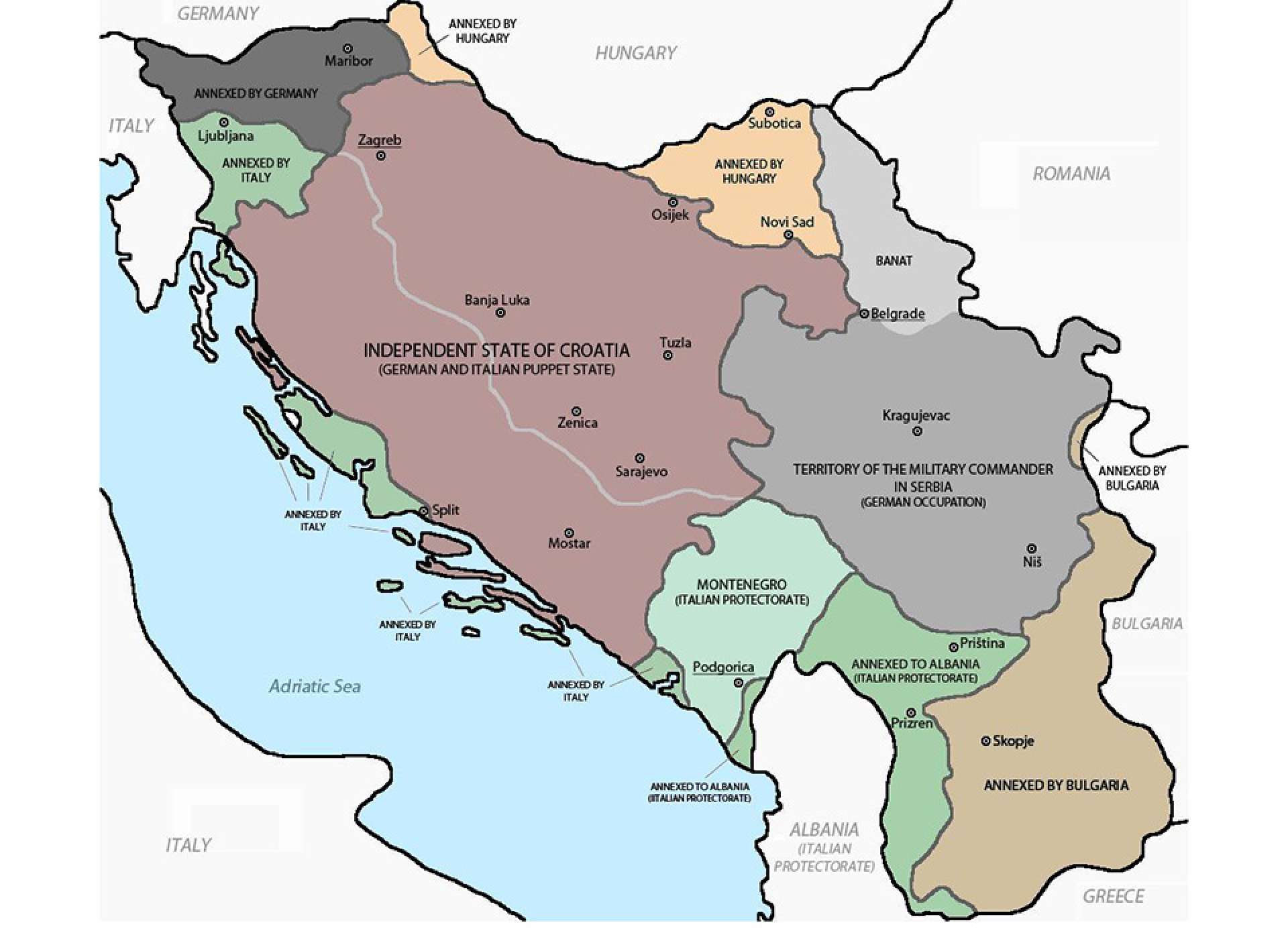
Political boundaries in Yugoslavia during World War II courtesy of Wikimedia Commons.
As the Axis armies arrived, the Yugoslav government fled to exile in London, its future uncertain. Armed resistance to foreign occupation and to domestic and international fascists commenced immediately. The two most well-known resistance armies were the Chetniks, who evolved from the remnants of the official Yugoslav army and supported the reintegration of Yugoslavia under a Serbian nationalist rubric, including the reinstallation of the Serb King, and the Communist Partisans, led by Josip Broz Tito, who adopted a wartime ideology of anti-fascism, “brotherhood and unity,” and the reunification of war-torn Yugoslavia within the framework of a socialist state.
The two resistance armies fought each other, even as they fought the same foreign and domestic enemies. The Partisans built a formidable army and comprehensive political and social system, besting their rivals. With support from the Allies, they systematically drove the Germans out of the Balkans. In 1945, they helped to win the war and promptly sought to reunify Yugoslavia.
Importantly, the breakup of Yugoslavia in 1941 was not universally detested, and the Partisans’ victory in 1945 was not universally embraced. Many people had welcomed Yugoslavia’s collapse and were empowered within Hitler’s new European order. These people came from various religious, ethnic, national, and political groups. Their reasons for supporting the collapse of Yugoslavia or the occupation regimes varied, but generally included some combination of having felt marginalized, robbed, and disenfranchised by the interwar Yugoslav state. They sought a stake in redefining the region’s political boundaries and its political character, and they hoped that participating in Hitler’s new European order would offer them a chance to do so.
From its foundation in 1918, the first Yugoslav state had faced widespread internal opposition. Some groups, such as Kosovar Muslims and certain Slovene and Croat nationalists, did not consent to being part of Yugoslavia and felt the state was forced upon them against their will. Many Montenegrins, who had their own state before 1918, balked at the dethronement of their king and the loss of their sovereignty. Even some people who supported the idea of Yugoslavia—understanding the South Slavs as a nation that should have national sovereignty—disagreed on the form and structure of the state, leading to political infighting and violence. The interwar Yugoslav government responded to this wide-ranging opposition with a combination of repression, authoritarianism, censorship, and policing.
For people who disliked the Yugoslav state, the rise of Mussolini’s Fascist Italy and the expansion of Hitler’s European empire in the 1930s offered the possibility of a different political future. This possibility became a reality in 1941, when the Axis powers restructured the political order of southeastern Europe and empowered some of the disempowered. While many people became disillusioned by fascist ideology, political marginalization, mass violence, ruthless occupation policies, and civil war, they did not come to consensus on what the best political alternative would be.
The cruelty and viciousness that characterized mass violence in wartime Yugoslavia has been well documented. The Ustasha regime went down in history as one of the most brutal Nazi satellite states. As historian Rory Yeomans has shown, in addition to imprisoning Jews, Serbs, and Roma in brutal concentration and death camps, the regime sent death squads into the countryside to burn down villages and slaughter Serbian civilians with “axes, knives, scythes, and mallets, as well as guns,” locked people in churches that were set on fire, and threw bodies, sometimes alive, into mass graves.
As insurrection grew and civil war escalated, they strung up bodies along the streets, desecrating the dead as a warning to the living. In Nazi-occupied Serbia, the German occupation regime instituted one of its harshest reprisal policies in Europe, executing 100 civilians for every German killed by the resistance. Tens of thousands of Serbs, Jews, and suspected Communists were put to death in mere months, after which the remaining Jews were systematically deported to German camps and killed.
Meanwhile, Chetnik units terrorized Muslims in Eastern Bosnia, burning villages, raping women, massacring civilians, and burying bodies in mass graves. Partisan units adopted a similar tactic with the Italian population in Istria, Dalmatia, and the Julian March, massacring civilians and throwing their bodies into cavernous, rocky sinkholes, known as foibe.
This is merely a selection of examples to give a sense of the scope of the mass violence perpetrated in the conflict. While historians and Balkan politicians regularly debate which side killed more people and in which ways, for our purposes, what matters most is the understanding that civilians across wartime Yugoslavia experienced terrorizing forms of state-sponsored and insurgent violence, producing mass trauma and fear.
The brutality of war convinced some people who had initially supported the Axis powers to switch sides: the Partisans’ platform of “brotherhood and unity” through social revolution was understood by many as the antidote to genocidal nationalism. But as the war ended and the new regime consolidated power, people doubted if a return to Yugoslavia or a socialist revolution would fix prewar problems, end discrimination, and create avenues for fair representation. Questions abounded. What would reunification and a socialist state mean for one’s political, property, and civil rights? How would the post-war state treat people who had worked for, sympathized with, or profited from the wartime regimes?
Some people feared political retaliation at the hands of their former enemies. Others expressed concern about the redistribution of wealth. Significant numbers of religious folks—Catholics, Muslims, Orthodox Christians—worried that the Communists would dismantle the religious underpinnings that had shaped the region’s social, cultural, and legal norms. Although the Communists initially promised religious freedom, the radical atheistic policies of Stalinism were well-known, and people were worried.
In spring 1945, it was by no means clear that post-war Yugoslavia would become a solidly Communist state. In the months after V-E Day, foreign diplomats and local politicians debated the political future of the region, as did the Yugoslav government-in-exile, which had made its wartime home in London. Would the Serbian King be restored to the throne and a royal democracy established? If so, would it look the same as the interwar Yugoslav state?
Many members of the Yugoslav government-in-exile in London hoped so. But the transitional government refused to allow the King to return to the country until a vote was held on whether the monarch would be revived. On the ground in Yugoslavia, many wondered: Would there be free and fair elections, as the British and Americans desired, and how would they be organized? What would be the difference between liberal democracy and socialist democracy? Early signs in summer 1945 pointed to the real possibility of a free political system: in local elections, opposition candidates occasionally beat those put forward by the People’s Front, the political organization dominated by the Communists.
But by the fall of 1945, it had become clearer that the Communist leadership had no plans to loosen its grip on power. Unlike other parts of Europe where the Allies had done the lion’s share of work to defeat the Germans, the Yugoslav Partisans knew that they had won, legitimately, and they expected to define and shape the country’s future form. In the public eye, they held jubilant celebrations and parades, opened schools and other institutions, published newspapers, and held local elections, hoping to consolidate victory through legitimate means. Liberation from the Nazis was celebrated as a collective victory.
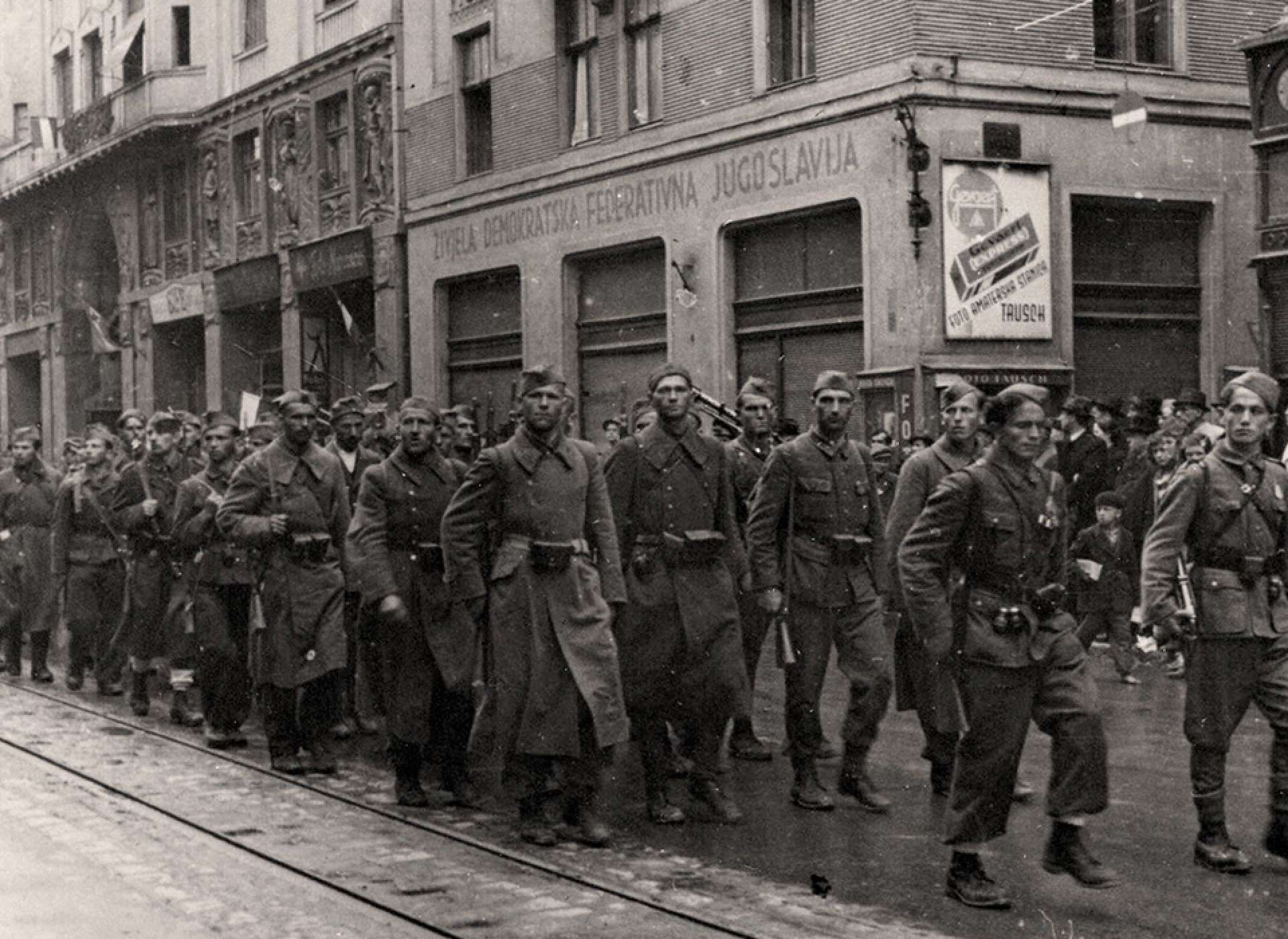
Partisans liberate Sarajevo, April 6, 1945, courtesy of Wikimedia Commons.
The Communist-led transitional government paired these tactics with more sinister ones: the suppression of oppositional organizations and the removal of their leaders, an expanding secret police apparatus that investigated and documented anti-state and anti-Communist activity, individual and mass arrests, imprisonments, trials, and an expanding culture of fear. People were arrested on a variety of charges, from egregious crimes against humanity during World War II to more mundane charges, like hiding grain or price gouging. Those found guilty lost political and civil rights, including the right to vote. Many received prison sentences or time in forced labor camps. Some were executed.
In November 1945, in the country’s first national elections, the Communists won with about 90 percent of the vote. They did so through impressive and widespread propaganda, coercion, the removal of political enemies, and election fraud. They promptly established the Federal Socialist Republic of Yugoslavia, a polity that drew upon a Soviet model. Their political plan involved the removal of class and political enemies and the consolidation of control in the hands of the Communist Party.
Economically, the regime introduced campaigns for nationalization and industrialization that aimed to eliminate private ownership, redistribute wealth, and elevate the working-class and peasantry. The Communists’ social revolution was grounded in ideals of class, gender, and national equality, which would be realized by eradicating deep-seated patriarchal networks and strong religious-based cultures, and replacing them with expansive educational, cultural, and social welfare structures as well as instituting a universal, secular legal code. All of this was put into motion over the winter of 1945-1946.
Conflict
Across Yugoslavia, people panicked. This panic quickly manifested in acts of subterfuge, dissent, and underground opposition movements, street protests, strikes, uprisings, and armed resistance. By the summer of 1946, endemic armed conflict had spread to different corners of the state.
The escalating conflict in 1946 was complex and multi-sided, and has proven difficult for historians to describe and categorize. Some armed insurgents had been fighting consistently since World War II ended, refusing to lay down their arms and accept Partisan victory or the new socialist state. This included well-known groups such as the Serb Chetniks, whose leader, Draža Mihailović evaded capture until March 1946.
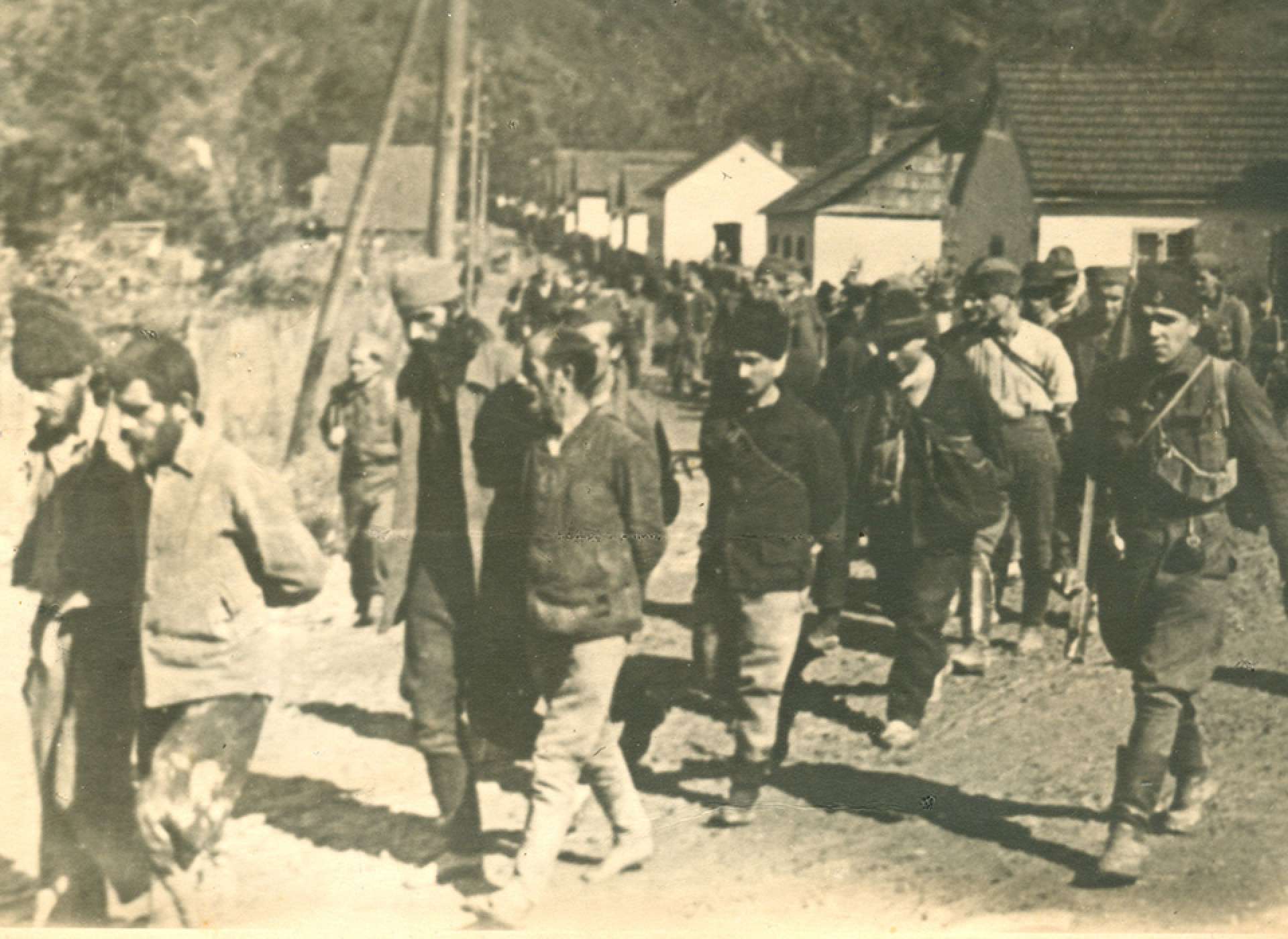
Captured Chetnik soldiers courtesy of Wikimedia Commons.
It also included bands previously associated with Balli Kombëtar, a nationalist Albanian army, which continued to wage war in Kosovo, Montenegro, and the Sandžak and had connections to nationalist fighters in Albania.
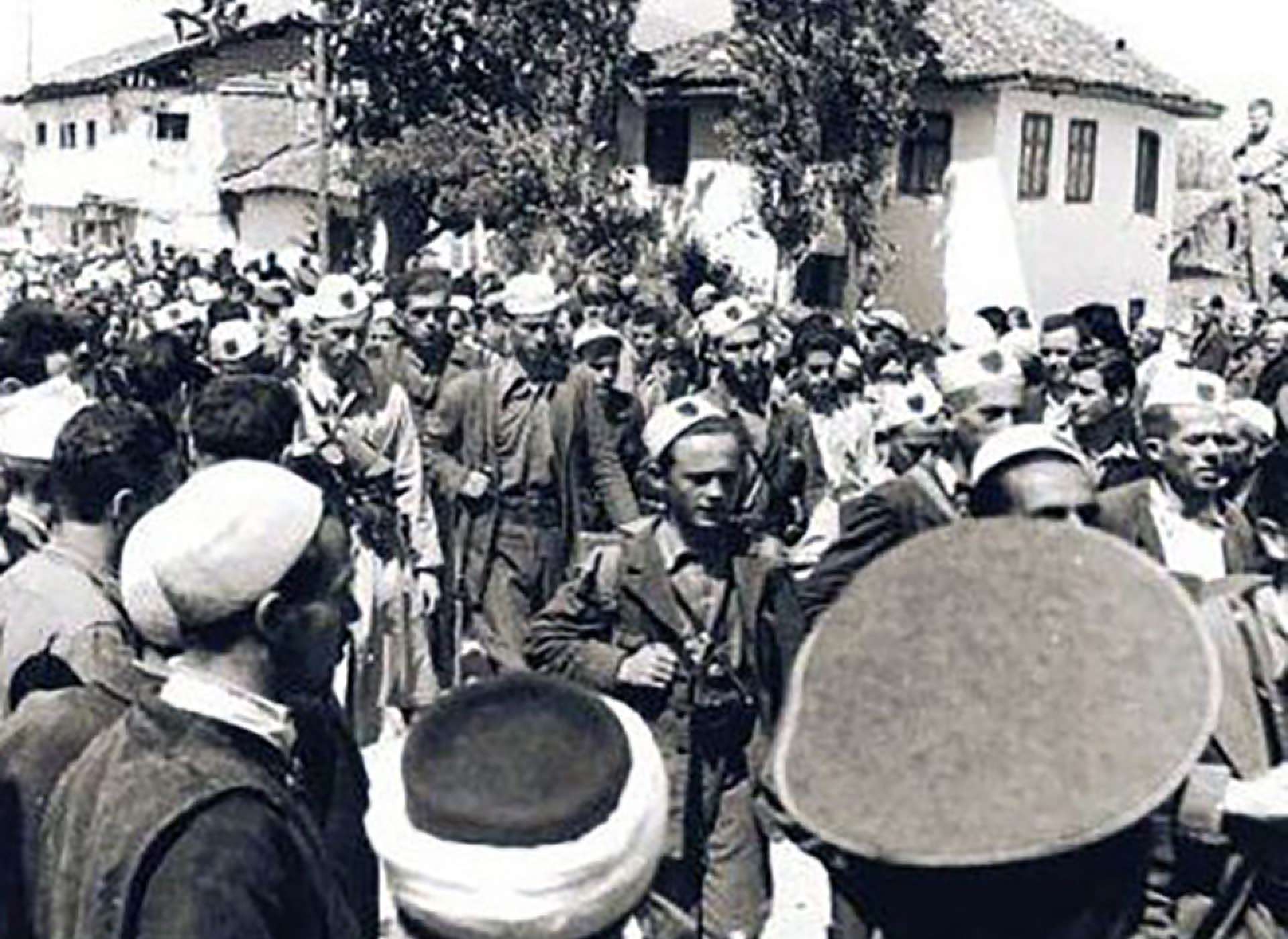
Balli Kombetar forces enter Prizren 1944, courtesy of Wikimedia Commons.
Post-war insurgency took on a different character in Slovenia and Croatia, regions that had been distinct fascist polities during the war. Small bands known as “Crusaders,” (Križari, Croatian; Križarci, Slovenian), incorporated wartime military and institutional structures and deployed them for a guerilla war against Communists. In the spirit of the Allied victory, Crusader units claimed to be advocates of democracy and religious freedom, but many members had violent fascist pasts.
The Croat Crusaders, who expanded to every corner of Croatia and also into Bosnia and Herzegovina, brought together Ustashas, Croat nationalists, political dissidents from the interwar Croat Peasant Party, and a range of Catholic refugees and civilians, often under the leadership of a former Ustasha officer. While many Crusader units operated independently, they can hardly be seen as informal bandits, anarchists, or rogue criminals: units often had their own priest, kitchen, dispensary, and auxiliary personnel, as well as a uniform. There were even efforts to create a flag.
The British estimated in fall 1946 that roughly 27 percent of the Croat population in Yugoslavia supported the movement. Their unofficial leader was a former Ustasha general, Vjekoslav Luburić, who had overseen the country’s notorious concentration camps and orchestrated the vicious public murders of men and women, old and young, in Sarajevo at the end of the war. . (I write about this campaign in my book, Sarajevo, 1941-1945). Importantly, however, not all Croats involved with the Crusader movement were war criminals and former fascists. People who supported liberation and had sympathized with or even fought with the Partisans also joined.
The Slovene anti-Communist front similarly integrated fascists, former members of the wartime Slovene Home Guard (also referred to as the White Guards), religious Catholics, and Slovene nationalists, some with violent wartime pasts, others without them. The movement became especially attractive to Slovene members of the Partisan army who had fought on the side of the Allies, but then changed their minds in the early months of the Communist consolidation of power. The Slovene movement steadily expanded into fall 1946 when, according to British reports, there were two mutinies in the Yugoslav army to the south of Maribor, Slovenia; in one, soldiers allegedly killed their political commissar and defected to the anti-Communist army.
Importantly, these insurgencies were not static. Alliances changed, as did membership. People had various motives for joining one group or another, with individual interests and circumstances often dictating whether people would fight, flee, or bide their time until dynamics became clearer. For instance, among the Chetnik units that continued fighting in post-war Serbia, Montenegro, and eastern Bosnia, some espoused a pan-Yugoslav agenda, while others fought for a distinct Serb nationalist cause. Some Kosovar Albanian guerrillas appeared to be more anti-Yugoslav than explicitly anti-Communist; national categories could prove more salient than ideological ones.
In Macedonia, the Greek Civil War trickled over the border, and bands of Serbs, Macedonians, and Bulgarians could be found fighting each other as well as fighting Yugoslav Partisans. Former members of the Ustashas and Chetniks, two groups that fought each other during World War II, found themselves guardedly working together or operating with something of a gentleman’s agreement. For many, this was a war against Communism. But it was also a battle over the legitimacy of socialist Yugoslavia.
A third subset of armed opposition is even more difficult to pin down. Whereas the Chetniks, Crusaders, and Ballists were fighting for a different political vision for the region, other smaller groups seemed to be fighting against the Communists, but without a defined idea of what should replace them. We find within this category Slavic-speaking Muslims in Bosnia and Herzegovina and the Sandžak, who fought in defense of Islam, as well as Turkish-speaking Muslims in Macedonian cities, who allegedly formed a clandestine movement called Yücel with support of the Turkish consul in Skopje. The Yugoslav courts sentenced three Yücel leaders to death in January 1947 after convicting them of charges of organizing unrest, espionage, preparing terrorist acts, and encouraging Muslims to resist the new Communist regime.
Violence spanned the spectrum from militia skirmishes to sabotage of railroads and state infrastructure; it also included attacks on Communist politicians and members of the armed forces. Many groups imitated the successful strategies of the wartime Partisan movement. They formed small armed units based in rural and mountainous regions, intermittently sneaking into cities where they participated in acts of sabotage and connected with activists and dissidents who provided material resources and moral support, and then fled to the forests or mountains to evade capture. The United Nations Relief and Rehabilitation Administration (UNRAA) reported in 1946 that 30 percent of all of its materials in the country were captured en route to their designated location.
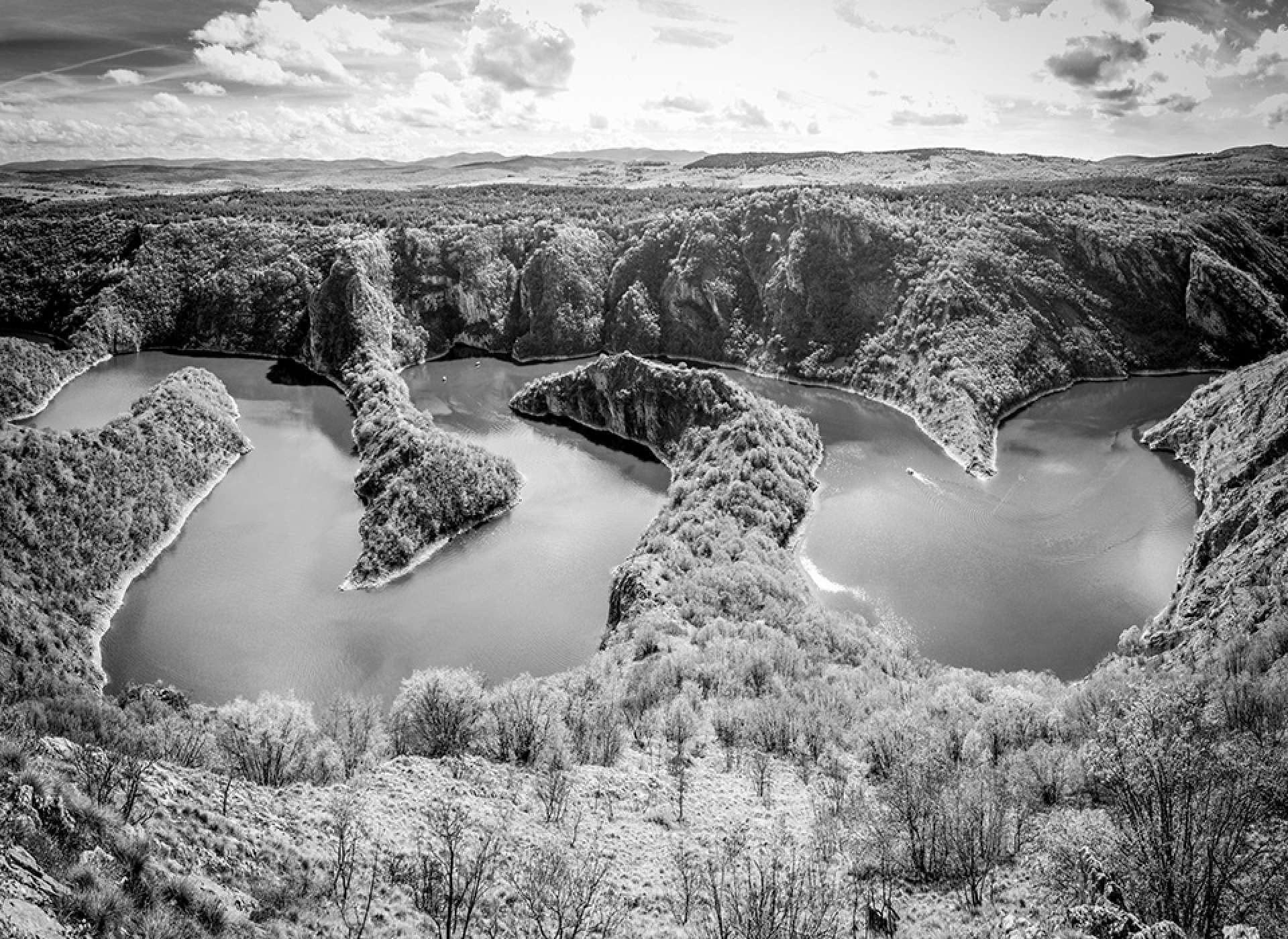
Mountains and the Uvac River, outside of Užice, Serbia. Photo by Matthew Worsnick.
Not all resistance took the form of insurgency or sabotage. Acts of protest and dissent included private activities, such as the infiltration of schools to provide a counter curriculum, recruiting people to different movements, and publishing and disseminating anti-Communist materials. At home, people secretly listened to Radio Europe and Radio Ankara, hoping for a Cold War rescue story. Some savvy members of the political elite reached out to foreign contacts, hoping for foreign intervention. Some workers went on strike. Some peasants rebelled to fight grain acquisition, most famously in Cazin in 1950.
Religious institutions also spearheaded campaigns of opposition. Priests led prayer services that warned of the dangers of Communism and encouraged parishioners to engage in a direct fight against the national government. Clandestine madrasas combined Islamic education with anti-Communist teachings. The relationship between civil resistance and armed resistance at this moment has not been adequately explored by historians, but we know that networks tended to include both armed and unarmed dimensions.
Yugoslav State Propaganda and Policies
Tito’s regime understood that they were at war. Initially, the Communist leadership viewed insurgents exclusively as remnants of their wartime enemies. In 1945, they hunted down, arrested, and tried anti-Communists on the grounds that they were war criminals—that is, people who had committed crimes against humanity during World War II. But their narrative was flawed. Many anti-Communists took up arms for the first time only after the war. By 1946, regional Communist party reports described an influx in new recruits to oppositional movements that included demobilized Partisan soldiers who were angered by the absence of paychecks and material resources or who felt betrayed by the revolutionary policies being introduced.
By March 1946, the Yugoslav secret police had taken into custody more than 7,000 members of the Yugoslav Armed forces, whom they accused of crimes ranging from treason to sympathy for the enemy. The internal purges were critical for establishing control. As historian Christian Nielsen has shown, the regime developed a complex secret policing strategy for tracking down and liquidating war criminals and guerrillas. Police skillfully turned communities against one another by offering amnesty to informers and publicizing the names of witnesses in trials: citizens were forced to choose to be either a witness or collaborator, an informant or a criminal.
Trials were often broadcast on radio and over loudspeakers in small towns, ensuring that even the illiterate understood what was happening. Public humiliation tactics included publishing names of the so-called criminals and ostracizing their family members. Both the alleged criminals and their families learned “to keep quiet,” as historian Max Bergholz argues, fearful of retaliation from both government and community.
Destroying civilian opposition proved tricky. Initially, many Communist officials believed idealistically that citizens engaged in oppositional activities because they were poor, starving, unemployed, and uneducated. Towns, villages, and infrastructure had been destroyed. Disease and famine were rampant during and after the war. Communist officials hoped that by building schools and factories, creating jobs and training opportunities, and connecting people to food, housing, health care, and material resources, they could demonstrate the benefits of socialist modernization and discourage resistance.
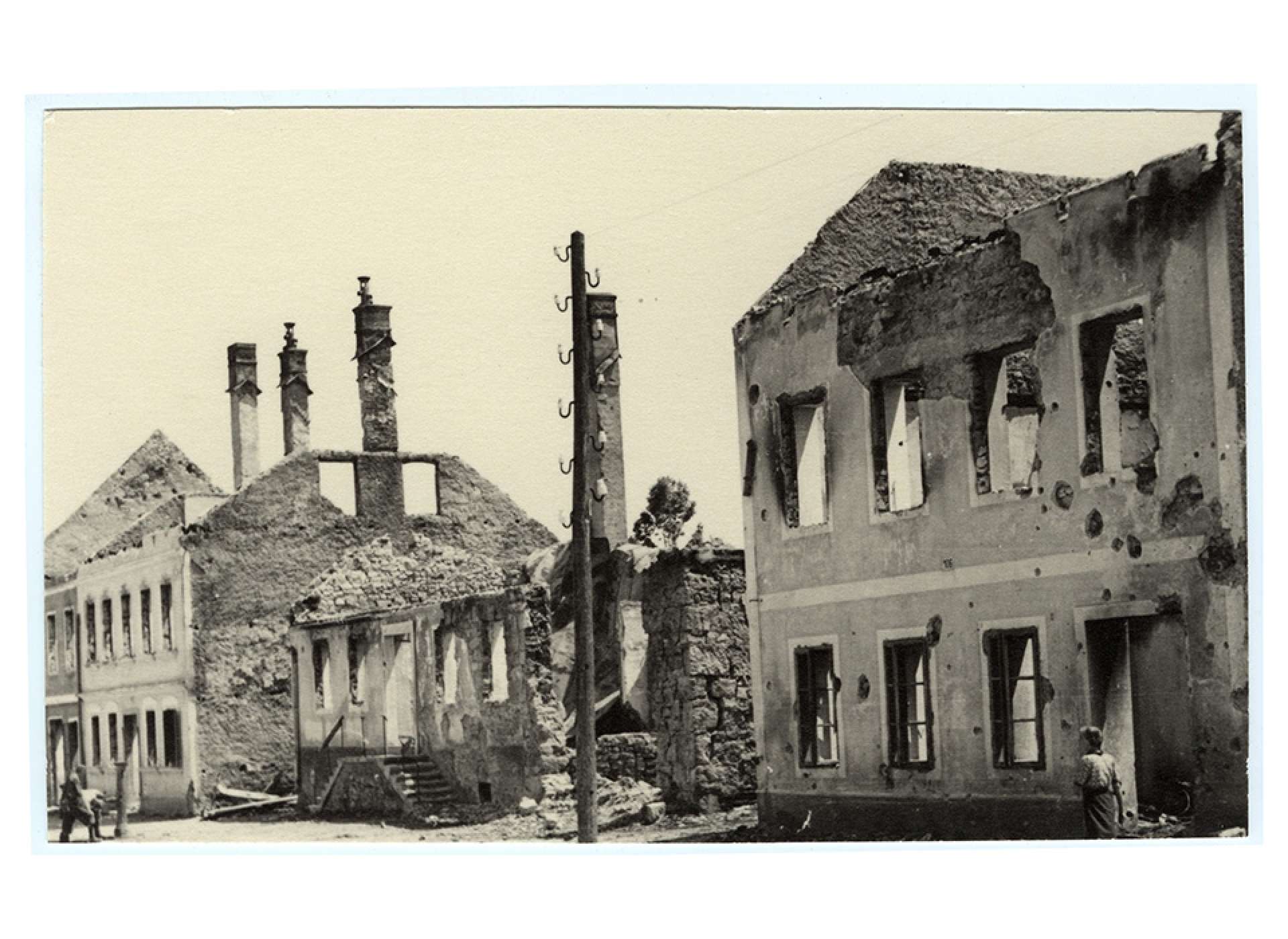
Ruins in postwar Yugoslavia. Image courtesy of the ICRC Audiovisual Archive, V-P-HIST-03173-09.
They were certainly on to something: as people settled into new lives and had access to more material comforts, resistance subsided. But in 1946, this was also an underestimation of people’s understanding of the crux moment in which they lived. In both literate and illiterate communities, in towns with electricity, schools, and newspapers, and also in villages without these things, in areas with significant numbers of former fascists, and even in areas where the Partisans had garnered a lot of support, people were willing to take up arms to fight the burgeoning communist state.
Hoping to sever recruiting pipelines, Tito’s regime especially targeted people who provided, or might be able to provide, moral leadership for resistance groups. In addition to arresting and putting on trial prominent military and religious leaders, such as the Chetnik leader Draža Mihailović and the Archbishop of Croatia, Alozije Stepinac, the Communists targeted mid-level elites, such as local politicians, wealthy merchants who had financial resources at their disposal, intellectuals with anti-Communist attitudes, and religious personnel. The latter were seen as especially dangerous because their networks spanned far and wide, especially in rural areas. In late 1945, for example, Catholic priest Ivan Čondrić found himself accused, among other things, of being an organizer for a “terrorist, crusader group” in Sarajevo, Zenica, and Busovača. Other Catholic priests shared his fate, convicted as enemies of the state and members of “Ustasha-Crusader” organizations.
Similar tactics were used against Orthodox clergy. The Party targeted Orthodox priests, reporting in 1946 that 90 percent of Orthodox priests opposed the regime. One priest found with the Chetniks, for example, was shot on the spot; others received lengthy prison sentences for merely sympathizing with the movement. In a public effort to sever Muslim communities from their traditional leadership, the regime arrested, humiliated, and imprisoned members of the ulema, Islamic legal and religious scholars, as well as men and women considered to be Islamic activists. Partly as a public warning, partly as a means of cutting ties between communities and religious leaders, the regime held show trials for important leaders in every confessional group, and executed some as a warning to others.
As they continued to consolidate power, the Communist regime depicted opposition as both illegitimate and insignificant. The state-controlled media in 1946 and 1947, as well as subsequent historical and political writings about the era, described a conglomerate of bandits, terrorists, reactionaries, and counterrevolutionaries in the service of the Communist movement’s villains: the clergy and the rich. Word choice in the reporting was crafty and deliberate: “bandits” implied criminality without proof. “Terrorists” had an international connotation as illegitimate rebels. “Reactionaries” and “counterrevolutionaries” served a post-war narrative, wherein the world was divided into fascists and anti-fascists. Anyone who was an anti-Communist was, by virtue of the semantic and ideological context, a fascist. And vice versa.
Missing Stories
As a historian, I have always been fascinated by histories that seem to be missing from public memory and historical accounts, or whose specifics seem fuzzy and uncertain. I remember coming home from the local archive in Tuzla, Bosnia-Herzegovina after reading local reports about violence in 1946, and saying to my husband: I think I may have found a civil war today.
In the years after, I sought out clues as I pursued research for other projects, sifting through foreign consular reports, Yugoslav secret police files, municipal Communist Party records, war crime investigations and trial transcripts, memoirs of activists, rebels, and émigrés, and reports from various international bodies. United Nations reports held in New York City, for example, describe Catholic guerrillas in northern Croatia and in Dalmatia, including some who fled under cover of night across the Adriatic, hoping to find refuge in Italy.
British consular officials in Sarajevo describe armed rebels in Bosnia and Macedonia. Local officials in provincial towns like Novi Pazar, Tuzla, and Pazin carefully documented regional insurgencies, while the Yugoslav War Crimes Investigative Commission and the subsequent trial records detailed thousands of incidents with enough contextual understanding to shed light on different movements. Historians call the conflict in neighboring Greece a civil war. But how do we categorize what was happening in Yugoslavia?
Despite the obvious existence of armed insurgents and a widespread anti-Communist front in 1946 and 1947, finding specific details on who participated, how units organized and were structured, and what different groups hoped to achieve, proved hard to decipher. I read books by historians such as Melissa Bokovoy, Jozo Tomasevich, Zdenko Radelić, Husnija Kamberović, Ivo Banac, Carol Lilly, and others mentioned in this text. But most historians focus on one aspect or particular group within this larger landscape of post-war violence: we remain without an overarching narrative that encompasses the scope and complexity of conflict in post-war Yugoslavia.
There are a few reasons for this. First is a methodological one. Most historians rely on primary sources found in archives, which are depositories of documents, oral testimonies, photographs, and other records. It is no secret that governments create and fund most archives. Consequently, they select what to keep and how to organize it, and thus tend, often unconsciously, to reinforce familiar and acceptable narratives. This is why we tend to find a larger number of government reports than potato receipts in state archives (though I once giddily waded my way through boxes of potato receipts from 1941, interspersed in which I discovered office notes related to the Holocaust).
In post-war Yugoslavia, the communists formed the government and thus took over and created archives. Consequently, the vast majority of post-war historical records are organized according to their institutions, agendas, and frameworks. For nearly a half-century, they chose what to document, preserve, and catalog, and also decided who would get access. The government funded archives, museums, and state institutions dedicated to researching the Communist Party, the history of workers, and the Partisans’ role in the war. It also invested time and money into publishing hundreds of volumes of documents and memoir testimonies on these themes.
These volumes told a particular narrative: that of Partisan victory, “brotherhood and unity,” and mass support for the socialist Yugoslav state against a foreign, fascist body. The narrative was reinforced through thousands of state-sponsored memorials and monuments that presented a unified public image of World War II. The Museum of Modern Art in New York City recently held a major exhibit on architecture in socialist Yugoslavia, featuring photographs and even models of many of these monuments.
By contrast, there was no archive of the anti-Communists. There was no museum for bandits, reactionaries, or insurgents. Many of the movements purposefully avoided creating any documents, erasing themselves in fear of getting caught by the secret police. Those who participated rarely left memoirs and testimonies about it, unless they escaped and went into exile, in which case they tended to be writing to persuade foreign audiences, rather than seeking to objectively document personal experiences. The names of people who fought against the Nazis and Ustashas, but not as Partisans, were rarely engraved on stone (though in a few cases, towns sneakily added them).
The fragmentation and heterogeneity of the post-war armed insurgents and civil resistance movements in Yugoslavia also made it difficult to create a narrative arc. Since there was no single movement, there was nothing to materially stitch together a comprehensive story. How do we put members of the fascist elite in the same story as peasants who fought for the Partisans, but then protested the requisition of their grain? Do civilians who fell victim to Yugoslav massacres belong in the same category as war criminals who the Communists killed alongside them? People like war stories that have easily identifiable groups and clear-cut good guys and bad guys. The multi-sided, unnamed, ethically complex, shifting movements of post-war Yugoslavia are harder for us to understand and to connect to.
Further confusing the stories that we have told ourselves, the Allies did not know what to do with the anti-Communist resistance. These movements did not fit neatly into their post-war plans either. The Partisans had been aligned with the Allies and their victory was central to the Allied victory. Many Allied officials believed that they deserved to be treated as the area’s legitimate government. At the time, both US agents working for UNRAA, and diplomats in the British foreign office, were accused of being overly sympathetic to the Communists. But importantly, the Communists had proven themselves useful allies, especially in investigating and prosecuting the war.
As early as 1944, representatives from the Communist movement in Yugoslavia began documenting war crimes and identifying war criminals, collecting more than 1.5 million documents, witness testimonies, and photographs that the United Nations would rely on to identify and prosecute war criminals who had fled Yugoslavia and gone into hiding. In the post-war years, the Allies worked closely with Yugoslavia’s War Crimes Commission on several investigations and important trials, thus lending the commission—and the socialist government—international legitimacy. Much of the postwar resistance had questionable wartime pasts, which created international stigmas that persist to this day. Indicative of the persistence of this particular narrative, a quick wikipedia search for “anti-Communists” in Serbia or Croatia directs the reader to the subcategory “fascists.”
Starting in the 1980s and continuing into the 1990s, historians and politicians in the Balkans have challenged Communist erasures and re-inserted the anti-Communists into their national histories, often with the intention of inverting blame. These new narratives perpetuate, by clearly inverting, the conceptual dichotomies of “good” and “evil” created in postwar Yugoslavia—this time, the Communists are evil and their opponents, the “anti-Communists,” are good. Known locally as “revisionism,” local historians rewrote the history of World War II and the postwar, depicting the Communists as morally compromised and the anti-Communists as righteous. Within the new system, one’s credentials for or against Communism have become, in many mindsets, more important than one’s complicity in the Holocaust or other crimes of mass violence.
To Name a War
No community in post-war Yugoslavia went unaffected by the conflicts that persisted in the post-war years, just like no community went unaffected by World War II. And yet, there is no consensus on what, precisely, this conflict was or what it should be called. How do we describe conflicts like those in the Yugoslav case, where multivalent and locally inflected groups aligned against an inchoate state and party structure? Was this a civil war, and if so, was it a continuation of war from the early 1940s or something different?
The well-known sociologist of Eastern Europe, Jan T. Gross, has argued for thinking about a period of social revolution from 1938-1948 in Eastern Europe. But the few attempts to do so in Yugoslavia—calling this a long era of civil war—have tended to do so in the service of constructing a moral equivalency between crimes of the Nazis and crimes of the Communists, and thus feel unsavory and agenda-driven. If done differently, labeling the era a multi-sided civil war might make sense, since at stake were questions of sovereignty and legitimacy. But then we run into the problem that there were many different “groups,” if we can even call them all “groups,” and they had vastly asymmetric power relations, structures, and goals: do we include a group of four bandits in the same narrative as an organized armed insurgency?
And was this an insurgency, is that the best term? Insurgents are usually understood as groups that seek to establish control over local populations by combining war-making with state-building tactics, such as social services and economic incentive. The anti-Communist movements in post-war Yugoslavia had neither physical control over huge territories nor the capacity to build alternate state institutions. On the contrary, they operated within society, within the same institutions and political frameworks that the Communists occupied, at times within the Communist Party and Yugoslav army itself.
Other terminology has moral implications that can be understood only in the particular context of the late 1940s. Take, for example, the term “guerilla warfare.” As the Cold War emerged, the idea of guerrilla warfare became associated with leftist guerrillas fighting colonialism and capitalism, whereas anti-Communism became fused with fascism and Nazism, a moral crime in the eyes of the world. “Resistance,” similarly, is too tinged with the ethical implications of the Second World War to sit comfortably with historians, especially because many anti-Communists were complicit in gruesome war crimes.
The complexities of the battle lines in post-war Yugoslavia, along with the disparate motives of different groups (and the many different individuals within those groups), have made it easy for western audiences to throw their hands up and say that Balkan history is just too complicated, or too violent, or too foreign to really understand. But to quote a recent tweet by the historian Elidor Mëhilli:
"Whenever there are Balkans kerfuffles—which is often—one hears: “This place is so complex, hard to understand.” The ‘this is very complex’ move can seem like a cover for not bothering with it."
Elidor Mehilli
All histories are layered and complex, and it is up to those of us who know these places to do the hard work of peeling back the layers and trying to make sense of what was happening. I’d like to suggest that by reckoning honestly and directly with the complexities of post-war violence and anti-Communist movements in 1945-46, even as we still try to piece it all together, we can begin to understand this conflict in a new light.
The conflicts of the 1940s cannot simply be seen as an extension of World War II, nor as a Cold War story of ideological competition, nor can they be distilled into a narrative of national competition, vendettas, and score settling, as so much of Balkan history is mistakenly framed. Instead, these conflicts need to be analyzed as part of a much bigger history of state-building in modern Europe, an extension of a struggle that began in the nineteenth century over how to take apart Europe’s great land empires and carve them up into sovereign states, and continued through two international wars and a wide-range of twentieth-century political experiments. In such a reframing of the post-war conflict, we might uncover and examine the multivalent sides of conflict, re-evaluate our categories of fascists and anti-fascists and of communists and anti-communists, and develop new historical narratives that seek not to silence opposition, but rather to clarify and understand.
Meet the Author
Emily Greble teaches History and East European studies at Vanderbilt University, and is the author of Sarajevo: Muslims, Christians, and Jews in Hitler’s Europe (Cornell, 2011) and Muslims and the Making of Modern Europe (Oxford, 2021). She lives in Nashville, TN with her husband and two sons.
This article is part of a series commemorating the 75th anniversary of the end of World War II made possible by the Department of Defense.
Cite this article:
MLA Citation:
APA Citation:
Chicago Style Citation:
